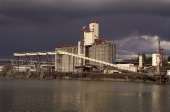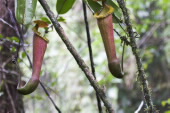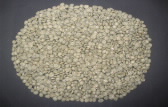FOR IMMEDIATE RELEASE
ACS News Service Weekly PressPac: March 31, 2010
ACS News Service Weekly PressPac: March 31, 2010
Contact
- Science Inquiries: Michael Woods, Editor, 202-872-6293
- General Inquiries: Michael Bernstein, 202-872-6042
![]()
How many gallons of water does it take to produce $1 worth of sugar, dog and cat food, or milk? The answers appear in the first comprehensive study in 30 years documenting American industry’s thirst for this precious resource. The study, which could lead to better ways to conserve water, is in ACS’ Environmental Science & Technology, a semi-monthly journal...
![]()

Scientists in the United Kingdom are reporting evidence that consumption of insects contaminated with a toxic metal may be a factor in the mysterious global decline of meat-eating, or carnivorous, plants. Their study describes how meals of contaminated insects have adverse effects on the plants. It appears in ACS’ semi-monthly journal Environmental Science & Technology. Iain Green...
![]()

Scientists in Brazil are reporting for the first time that coffee beans contain proteins that can kill insects and might be developed into new insecticides for protecting food crops against destructive pests. Their study, which suggests a new use for one of the most important tropical crops in the world, appears in ACS’ Journal of Agricultural and Food Chemistry, a bi-weekly publication...
![]()

The “vegetable lamb” plant — once believed to bear fruit that ripened into a living baby sheep — produces substances that show promise in laboratory experiments as new treatments for osteoporosis, the bone-thinning disease. That’s the conclusion of a new study in ACS’ monthly Journal of Natural Products. Young Ho Kim and colleagues point out that osteoporosis is a global health problem, affecting up to 6 million women and...
![]()
Here’s a paradox for Passover and year-round: With observant Jews numbering barely one million in a United States population of 310 million, why are 40-50 percent of food items on supermarket shelves kosher? Those and other insights into the amazing and constantly growing popularity of kosher foods appear in an article in Chemical & Engineering News (C&EN), ACS’ weekly newsmagazine. C&EN Senior Editor Bethany Halford notes that the number of kosher products on supermarket shelves has grown from about 3,000 in…
![]()
Journalists’ Resources

- Save the Date: ACS Fall 2010 National Meeting
Join thousands of scientists gathering in Boston August 22-26, 2010 for the 240th National Meeting & Exposition of the American Chemical Society. Watch for further information in the months ahead. - Press releases, briefings, and more from ACS’ 239th National Meeting
www.eurekalert.org/acsmeet.php
http://www.ustream.tv/channel/acslive - Must-reads from C&EN: More methane escaping from oceans into atmosphere
Methane, a potent greenhouse gas, is seeping from under the Arctic Ocean into the atmosphere in amounts that exceed those of all the other oceans combined. Scientists are trying to determine whether oceanic warming due to climate change might further increase the outgassing of methane. More on methane. - ACS Pressroom Blog The ACS Office of Public Affairs’ (OPA) pressroom blog highlights research from ACS’ 38 peer-reviewed journals and National Meetings.
- Bytesize Science blog Educators and kids, put on your thinking caps: The American Chemical Society has a blog for Bytesize Science, a science podcast for kids of all ages.
- ACS satellite pressroom: Daily news blasts on Twitter
The satellite press room has become one of the most popular science news sites on Twitter. To get our news blasts and updates, create a free account at https://twitter.com/signup. Then visit http://twitter.com/ACSpressroom and click the ‘join’ button beneath the press room logo. - C&EN on Twitter
Follow @cenmag <http://twitter.com/cenmag> for the latest news in chemistry and dispatches from our blog, C&ENtral Science <http://centralscience.org>. - ACS Press Releases
Press releases on a variety of chemistry-related topics. - General Chemistry Glossary
- Chemical Abstracts Service (CAS) Web site on everyday chemicals
Whether you want to learn more about caffeine, benzoyl peroxide (acne treatment), sodium chloride (table salt), or some other familiar chemical, CAS Common Chemistry can help. The new Web site provides non-chemists and others with useful information about everyday chemicals by searching either a chemical name or a corresponding CAS Registry Number. The site includes about 7,800 chemicals of general interest as well as all 118 elements from the Periodic Table, providing alternative names, molecular structures, a Wikipedia link, and other information. - Science Connections from CAS
CAS - Science Connections is a series of articles that showcases the value of CAS databases in light of important general-interest science and technology news. Topics range from fruit flies to Nobel Prize winners, with the CAS - Science Connections series pointing to CAS databases for a more complete understanding of the latest news.
- Bytesize Science
Bytesize Science is a science podcast for kids of all ages that entertains and educates, with new high-definition video podcasts and some episodes in Spanish. Subscribe to Bytesize Science using iTunes. No iTunes? No problem. Listen to the latest episodes of Bytesize Science in your web browser. - Global Challenges/Chemistry Solutions
This special series of ACS podcasts focuses on some of the 21st Century’s most daunting challenges, and how chemists and other scientists are finding solutions. Subscribe at iTunes or listen and access other resources at the ACS web site www.acs.org/GlobalChallenges. - Science Elements
Science Elements is a podcast of PressPac contents that makes cutting-edge scientific discoveries from ACS journals available to a broader public audience. Subscribe to Science Elements using iTunes. Listen to the latest episodes of Science Elements in your web browser. Science Elements is on Facebook, friend it to see the latest updates and information. - SciFinder® Podcasts
Interested in healthful plant phytochemicals, nanotechnology, or green chemistry? Check out the SciFinder series of podcasts, which explore a vast array of current interest topics and new discoveries in the 21st century. The SciFinder podcasts are available in English, Chinese, Japanese, and Portuguese.
Note to Journalists and Other Viewers
This is the latest American Chemical Society (ACS) Office of Public Affairs Weekly PressPac with news from ACS’ 38 peer-reviewed journals and Chemical & Engineering News.
This information is intended for your personal use in news gathering and reporting and should not be distributed to others. Anyone using advance ACS Office of Public Affairs Weekly PressPac information for stocks or securities dealing may be guilty of insider trading under the federal Securities Exchange Act of 1934.
Please cite the individual journal, or the American Chemical Society, as the source of this information.
The American Chemical Society is a nonprofit organization chartered by the U.S. Congress. With more than 161,000 members, ACS is the world’s largest scientific society and a global leader in providing access to chemistry-related research through its multiple databases, peer-reviewed journals and scientific conferences. Its main offices are in Washington, D.C., and Columbus, Ohio.

